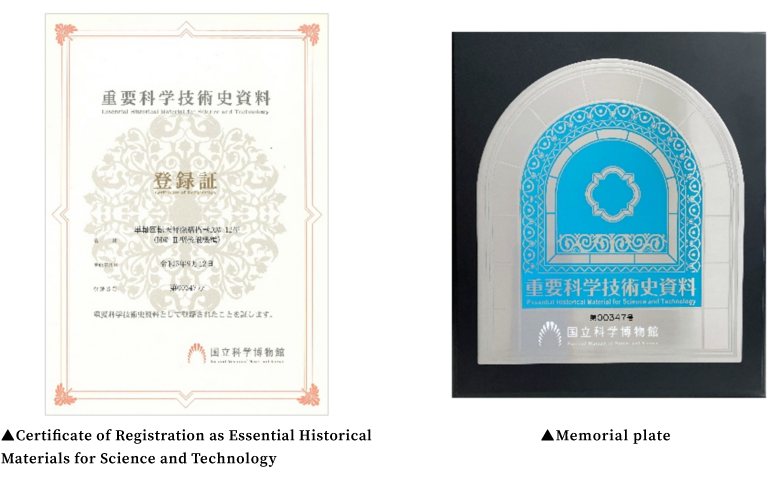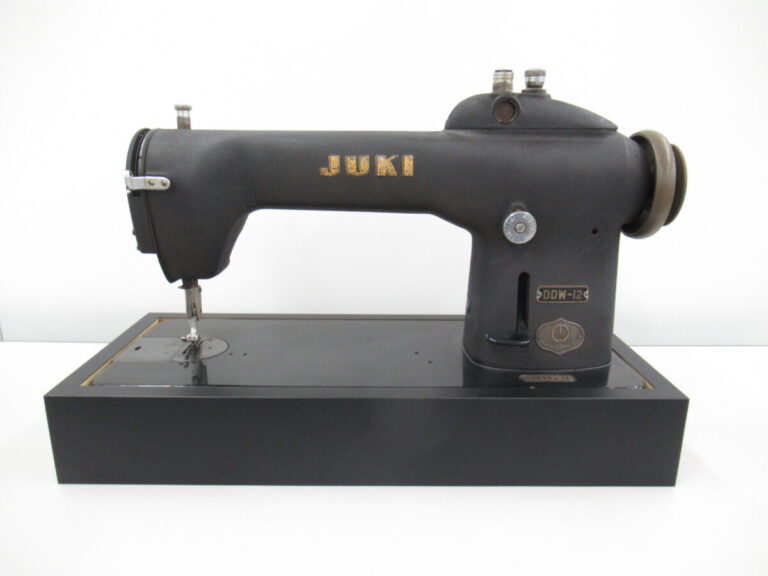JUKI sewing machines are registered as “Essential Historical Materials for Science and Technology (MIRAI Technology Heritage).

The DDW-12 industrial sewing machine developed and manufactured by TOKYO JUKI INDUSTRIAL CO., LTD,, a forerunner of JUKI CORPORATION (“JUKI”) and the HA-1 industrial sewing machine manufactured by Mitsubishi Electric Company, a forerunner of JUKI TECHNOSOLUTIONS CORPORATION, were registered in 2023 by the National Museum of Nature and Science (Ueno, Tokyo) as “Essential Historical Materials for Science and Technology (MIRAI Technology Heritage).”
The registration system for “Essential Historical Materials for Science and Technology (MIRAI Technology Heritage)” covers all science and technology in Japan. The system was established to preserve materials and utilize technologies that meet the following three criteria:
- They have brought about important results in the development of science and technology, industrial technology, etc. from a historical perspective,
- They are significant enough to be passed on to future generations.
- They have had a remarkable impact on the living styles, economy, society, and culture of Japan.
Products registered as “Essential Historical Materials for Science and Technology (MIRAI Technology Heritage)” will be exhibited on panels at the National Museum of Nature and Science from September 12 (Tue) to September 24 (Sun).
Product details
Model DDW-12, the successor to the DDW-II, equipped with a single-axis rotational thread take-up lever mechanism – A foundation for the development of industrial sewing machines in Japan

◆Reasons for selection:
JUKI Model DDW-12 in a picture inherited industrial sewing machine technologies originating in the Model DDW-II released in 1953.
The Model DDW-II was the first industrial sewing machine to incorporate JUKI’s single-axis rotational thread take-up lever mechanism. Overseas manufacturers had tried but failed to develop a comparable mechanism in their own machines, concluding it to be impossible. Japanese sewing machine technology has surpassed that of overseas competitors ever since the release of the DDW-II. Later, the DDW-II technologies were succeeded by the DDW-12, the foundation for the development of industrial sewing machines in Japan.
The existing Model DDW-12, a direct successor to the DDW-II, was released in 1956. The mechanisms built into the DDW-12 are now believed to epitomize the sophistication of Japanese sewing machine technologies at the time of the model’s release.
The Model HA-1 household sewing machine – A typical example of a machine marking a new start for the postwar sewing machine industry

◆Reasons for selection:
In 1947, shortly after the end of the war, domestic sewing machine manufacturers jointly compiled a “standard drawing for the Model HA-1 sewing machine” under the Sewing Machine Manufacturers’ Association. A number of different companies manufactured the Model HA-1 based on the drawing.
The standardized drawing contributed greatly to the performance, quality, and mass production of domestic sewing machines.
The selected machine was produced by Mitsubishi Electric Corporation, a company that had been manufacturing sewing machines since before the war. The instruction manual prepared at that time has been preserved. JUKI TECHNOSOLUTIONS CORPORATION, a joint venture company established with one of the Mitsubishi Electric Group companies, is now responsible for the business operations.
The machine was recognized as a prime example of a fresh start for the postwar sewing machine industry.
Panel exhibition details
◆MIRAI Technology Heritage / Panel Exhibition
Display period: September 12 (Tue) to September 24 (Sun), 2023
Venue: Japan Pavilion 1F, Central Hall, the National Museum of Nature and Science
For more information, please visit the National Museum website National Museum of Nature and Science,Tokyo (https://www.kahaku.go.jp/english/).
Details on the Essential Historical Materials for Science and Technology registered in 2023 (MIRAI Technology Heritage)
Twenty materials were registered, including two related to JUKI.
Essential Historical Materials for Science and Technology :: Center of the History of Japanese Industrial Technology (https://sts.kahaku.go.jp/english/)